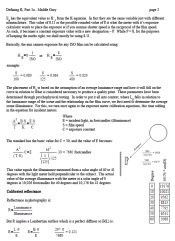RalphLambrecht
Member
The majority of light meters are not made in the USA and likely were not in the past.
I agree;It's more likely ,the sun is calibrated to the Gossen standard.

The majority of light meters are not made in the USA and likely were not in the past.

Agree wholeheartedly!

Fred,
What happens if you meter off caucasian skin and place that reading on Zone VI.
Does incident light reading of that same scene agree with the reflected light reading placed on Zone VI?
I find that it does, and this makes me think a Zone VI reference placed on Zone VI is a better double-check for incident reading... Than a reading from an 18% gray card placed on Zone V where it does not belong.
since we know different makes of meter use different K factors, they would all need to be using the K factor to meet the standard. Methinks that isn't the case and therefore they are not all calibrated to the Ansi standard. They may use the Ansi standard as their baseline but not comply with it exactly.
ending up with a different calibration for every camera-lens combination?
The majority of light meters are not made in the USA and likely were not in the past.
ending up with a different calibration for every camera-lens combination?



Thanks Bill.
From the link http://64.165.113.140/content/benskin/
Defining K
An Interpretation of Current Exposure and Meter Technology
Calibration Levels of Film and Exposure Devices
From Defining K
View attachment 98391 View attachment 98392 View attachment 98393
So how to take reflective readings vs. incident readings into consideration when shooting chromes vs. negatives?
Interestingly, all compare within +/- 0.1 stop in incident mode using the sun on an absolutely clear day. They all read within +/- 0.1 stop reading an 18% gray card in the same light, but, they all read exactly 1 stop less exposure than they do in incident mode.
| Photrio.com contains affiliate links to products. We may receive a commission for purchases made through these links. To read our full affiliate disclosure statement please click Here. |
PHOTRIO PARTNERS EQUALLY FUNDING OUR COMMUNITY:  |